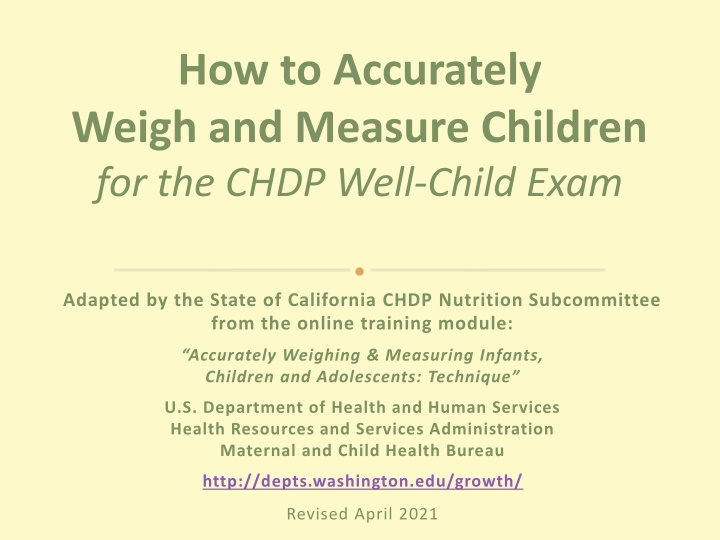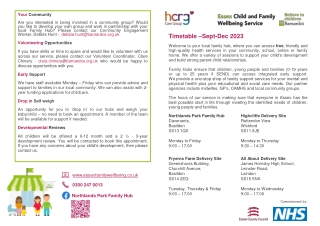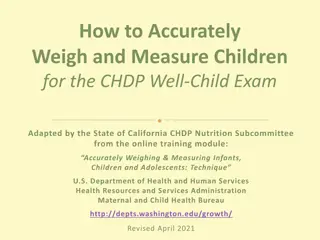Proper Techniques for Weighing and Measuring Children in CHDP Well-Child Exams
This article provides guidance on accurate weighing and measuring of children during CHDP well-child exams. It covers the importance of measurements, accurate techniques, interpreting BMI data, guiding providers for further assessments, and respecting privacy. Learn to manage challenges and ensure accurate measurements for a comprehensive assessment.
Download Presentation

Please find below an Image/Link to download the presentation.
The content on the website is provided AS IS for your information and personal use only. It may not be sold, licensed, or shared on other websites without obtaining consent from the author.If you encounter any issues during the download, it is possible that the publisher has removed the file from their server.
You are allowed to download the files provided on this website for personal or commercial use, subject to the condition that they are used lawfully. All files are the property of their respective owners.
The content on the website is provided AS IS for your information and personal use only. It may not be sold, licensed, or shared on other websites without obtaining consent from the author.
E N D
Presentation Transcript
How to Accurately Weigh and Measure Children for the CHDP Well-Child Exam Adapted by the State of California CHDP Nutrition Subcommittee from the online training module: Accurately Weighing & Measuring Infants, Children and Adolescents: Technique U.S. Department of Health and Human Services Health Resources and Services Administration Maternal and Child Health Bureau http://depts.washington.edu/growth/ Revised April 2021
Objectives By the end of this presentation you will be able to: Accurately weigh a child Accurately measure a child Manage common problems encountered
Measurements You Take Are Important Height, length, and weight alert providers to: Growth problems Feeding problems Emotional or social problems Illness
Accurate Measuring Is Critical BMI for 5 year old boy Weight: 43.5 lb Height: 43.0 in BMI = 16.5 BMI-for-age = 75-84th percentile Normal range If height is inaccurate: Weight: 43.5 lb Height: 42.5 in BMI = 17.0 BMI-for-age = 85-94th percentile Overweight range
Your Measurements Guide Providers In-depth Medical Assessment Obese Take and Plot Measurements Abnormal BMI % Growth Chart Overweight Lab Tests (cholesterol & glucose) Weight Height Age BMI Normal* Normal Underweight *Further tests may be warranted depending on family history Notein chart: Counsel & Follow-up
Your Measurements Guide Many Others HeadStart WIC Your Schools Measurements BMI % Growth Chart Weight Height Age BMI Parents
What challenges do you face? How do you handle them?
Respect Privacy Use a private area or exam room for the following: Removal of clothing and donning gown Taking measurements Discussing results
Before you begin: 1. Determine equipment needed for infant and child 2. Make sure equipment is clean, safe, and in good condition 3. Using a balance scale? Set to zero 4. Using a digital scale? Press the zero key to zero the indicator
Measure Lying or Standing? Length (Lying) Use Birth 24 months WHO growth chart Unable to stand without assistance* Stature (Standing) Able to stand without assistance Use 2 20 years CDC growth chart
Measuring Infants Length Equipment Needed: Measuring board Movable foot piece Rigid headboard Marked to 1/8 Need assistant
Inappropriate Methods of Measuring Measuring tape or yardstick attached to tabletops Measuring between 2 pencil marks on exam table
Measuring Infants Length 1. Measure infant wearing only clean, dry diaper. No shoes. 2. Lay infant on back. 3. Assistant or parent holds head firmly against the headboard. 4. With one hand, hold infant knees down, straightening the hips and knees.
Measuring Infants Length 5. With the other hand, move the footboard until it is resting firmly against infant heels. Toes point directly up. 6. Measure length to nearest 1/8 .
Measuring Height (Stature) Equipment Needed: Vertical stadiometer (height rod): Movable horizontal headboard Marked to 1/8 Attached to a firm, vertical surface (without baseboard)
Inappropriate Methods of Measuring Measuring tapes Yardstick or poster attached to wall Height rod attached to scale
Measuring Height (Stature) 1. Remove shoes and outer clothing (jackets, hats). 2. Child stands on a bare, flat surface with heels slightly apart; back as straight as possible. 3. Heels, buttocks, head and shoulders blades touch the wall or measuring surface. 4. Eyes should be straight ahead, arms at side, and shoulders relaxed.
Measuring Height (Stature) 5. Ask child to stand as tall as possible, keeping heels on the ground. 6. Slowly lower headboard until it touches the crown of the head firmly. 7. Check the child s position. Measurer s eyes are parallel with the headpiece. 8. Measure height to the nearest 1/8 .
Weighing Infants & Toddlers Equipment needed: Beam balance or electronic scale At least 35 lb capacity Weigh in 10 g or oz increments Large tray to fully support infant Can be easily zeroed and calibrated
Weighing Infants & Toddlers Up to 36 months if unable to stand without assistance
Weighing Infants & Toddlers 1. Weigh infant wearing only light underclothing or a clean, dry diaper. 2. Place infant in the center of the scale tray. 3. If using a beam scale, move lower weight from the zero until marker drops below the center point. 4. Weigh infant to nearest 10 grams or oz. 5. Record weight right away. 6. If using beam balance, return upper and lower weights to zero.
Alternate Weighing Method 1. Weigh parent and child together = Total Weight 2. Weigh parent alone 3. Total Weight minus Parent s Weight = Child s Weight
Weighing Children & Adolescents Equipment Needed: Beam or electronic scale Weigh in 100 g or lb increments Large platform to support the child No length device attached No remote display with attachment cord
Weighing Children & Adolescents Weigh in: Undergarments Gown Lightweight clothing Socks/bare feet
Weighing Children & Adolescents 1. Remove bulky outer clothing (jackets and sweaters) and shoes. Empty pockets of contents. Use clean dry diaper. 2. Balance and zero the scale. 3. Have the child stand in the center of the scale, feet slightly apart. 4. Read the measurement to nearest 100 gram or lb. 5. Record the measurement right away.
Additional Growth Chart Training Modules http://depts.washington.edu/growth/ U.S. Department of Health and Human Services Health Resources and Services Administration (HRSA) Maternal and Child Health Bureau
References Health Resources and Services Administration (HRSA) is part of the U.S. Department of Health and Human Services and helps provide health resources for medically underserved populations. http://www.hrsa.gov/index.html Photo Credit Photos with permission. Ventura County CHDP Program and Mandalay Bay Women and Children's Medical Group, August 19, 2011. Ventura County Health Care Agency. http://www.vchca.org/























